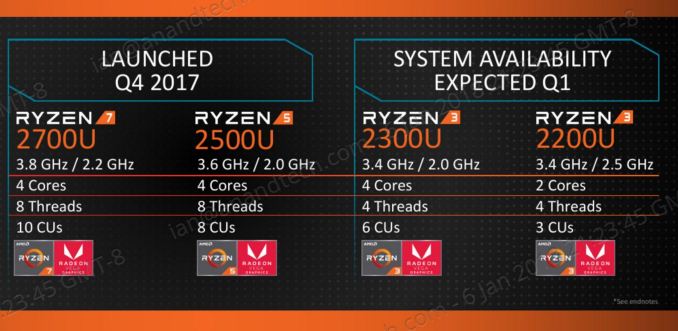AMD Tech Day at CES: 2018 Roadmap Revealed, with Ryzen APUs, Zen+ on 12nm, Vega on 7nm
by Ian Cutress on February 1, 2018 8:45 AM ESTZen Cores and Vega
Ryzen 3 Mobile, Plus More Ryzen Mobile Laptops
The most immediate announcement from AMD is two Ryzen 3 Mobile processors designed to fill out the Mobile stack, and the introduction of Ryzen-based APUs for desktop machines.
At the heart of both of these designs is the combination of AMD’s first-generation Zen cores, specifically four cores in a ‘core complex’, connected to Vega-based graphics integrated into the silicon. The two units are connected via AMD’s Infinity Fabric, designed for high-bandwidth and scale, and a feature that permeates through AMD’s recent product portfolio.
Ryzen Mobile
To date, AMD has already announced two products using this configuration. Both of them are for Ryzen Mobile, specifically the Ryzen 7 2700U and Ryzen 5 2500U, which have already been pre-announced in devices such as the HP Envy x2, the Lenovo Ideapad 720S, and the Acer Swift 3. Only the HP Envy x2 has been launched into the market so far (with mixed reviews due to the OEM design, which draws similar criticisms when equipped with Intel CPUs), with the others to see light in Q1 as well as other OEMs like Dell.
The first announcement is regarding adding more Ryzen Mobile processors to the family to cater for a wider audience. To pair with the Ryzen 7 Mobile and Ryzen 5 Mobile, AMD has two Ryzen 3 Mobile parts which will formally be available on January 9th with expected system availability within Q1.
| AMD Ryzen Mobile APUs | |||||
| Ryzen 7 2700U with Vega 10 |
Ryzen 5 2500U with Vega 8 |
Ryzen 3 2300U with Vega 6 |
Ryzen 3 2200U with Vega 3 |
FX-9800P (2015) |
|
| CPU | 4C / 8T 2.2 GHz Base 3.8 GHz Turbo Zen 14nm |
4C / 8T 2.0 GHz Base 3.8 GHz Turbo Zen 14nm |
4C / 4T 2.0 GHz Base 3.4 GHz Turbo Zen 14nm |
2C / 4T 2.5 GHz Base 3.4 GHz Turbo Zen 14nm |
Dual Module 2.7 GHz Base 3.6 GHz Turbo Excavator 28nm |
| GPU | Vega 10 10 CUs 640 SPs < 1300 MHz |
Vega 8 8 CUs 512 SPs < 1100 MHz |
Vega 6 6 CUs 384 SPs |
Vega 3 3 CUs 192 SPs |
GCN 1.2 8 CUs 512 SPs > 758 MHz |
| TDP | 15W | 15W | 15 W | 15 W | 15W |
| DRAM | Up to DDR4-2400 | DDR4-1866 | |||
| L2 Cache | 512 KB/core | 1 MB/module | |||
| L3 Cache | 1 MB/core | 4 MB/core | - | ||
| PCIe Lanes | ? | ? | ? | ? | 8 x PCIe 3.0 |
| Die Size | 209.78 mm2 | 250.4 mm2 | |||
| Transistors | 4.95 billion | 3.1 billion | |||
| Launch | October 2017 | January 2018 | May 2016 | ||
The Ryzen 3 2300U is a quad-core processor without simultaneous multithreading, which separates it from the other components. The base frequency of 2.0 GHz, a top turbo of 3.4 GHz, and a total of six compute units in the Vega graphics (this equates to 384 streaming processors). The Ryzen 3 2300U shares the same TDP as the other parts, coming in at 15W, and AMD wants to position this as a high-performance part for eSports capable notebooks, handily beating anything from Intel’s 7th Generation family.
The Ryzen 3 2200U is the only dual core component in AMD’s entire Ryzen product line, although it does have simultaneous multithreading to give it four threads in total. Having two fewer cores to fire up does give it a boost on the base frequency, coming in at 2.5 GHz, but the turbo frequency matches the other Ryzen 3 at 3.4 GHz. The 2200U is certainly the processor bringing up the rear, with only three compute units (192 streaming processors) in total, and helping AMD shift some of the processors that are not binned as aggressively as the higher-performance units.
AMD is promoting these two processors as capable elements of an entry level 15W notebook that can process DirectX 12, offer advanced video features, and be used in aesthetically pleasing designs with a long battery life, including 2-in-1s, ultrathin notebooks, and gaming laptops.
New Devices
Not to be content with just announcing a couple of new Ryzen Mobile processors, AMD was eager to promote new mobile devices that will be using Ryzen Mobile. To accompany the HP Envy x360, the Lenovo Ideapad 720S, and the Acer Swift 3, Q1 will see the launch of a new HP (under embargo until later this week), the Acer Nitro 5 series, and the Dell Inspiron 5000 series.
Acer’s Nitro line of laptops is typically aimed at the gaming crowd. The Nitro 5 dictates a 15.6-inch display, which in this case is a 1920x1080 IPS panel. Acer will use the pre-announced higher-end APUs, the Ryzen 7 2700U and Ryzen 5 2500U, but will also be pairing this with a Radeon RX 560 graphics chip. We were told by AMD that the integrated graphics and discrete graphics will be used in a switching context: for video playback, the lower power integrated graphics is used and the discrete is disabled, however the discrete graphics is fired up for gaming work. For compute, or for games that support multi-adaptor DirectX 12 technologies, both the integrated graphics and the discrete graphics should be available, however this is up to the game/software to implement.
The Dell Inspiron lines are more home/small-medium business-oriented devices, and here Dell is also using the Ryzen 7 2700U and Ryzen 5 2500U processors to offer peak Mobile APU performance. Designed more as a workhorse than for aesthetics, the Inspiron 5000 will offer AMD parts with 15.6-inch and 17-inch displays in a chassis that can support dual HDD/SSD options. The unit also comes with an optional Radeon 530 discrete GPU, which has 384 compute units based on AMD’s older GCN 1.0 architecture. This comes across as very odd, given that even the Ryzen 5 has 512 compute units of the newer Vega architecture. I can only assume that this provides extra displays for very specific customers, though for most it would seem an overly pointless addition.














131 Comments
View All Comments
mode_13h - Thursday, February 1, 2018 - link
Also, cardiovascular risk factors are known to affect brain health.mode_13h - Thursday, February 1, 2018 - link
Everything is fine... until one day, it's not. I have a co-worker somewhat like you describe (though he probably ate a bit better than that). He had a massive heart attack. He's still with us, but such an event is probably more costly and disruptive to one's life than simply taking better care of yourself.mode_13h - Thursday, February 1, 2018 - link
BTW, coffee is probably a net-positive, as long as you keep the cortisol in check and don't add lots of sugar.MFinn3333 - Saturday, February 3, 2018 - link
It is incredibly easy to get Vitamin D outside of the Pacific Northwest or similiar environments..."If you're fair skinned, experts say going outside for 10 minutes in the midday sun—in shorts and a tank top with no sunscreen—will give you enough radiation to produce about 10,000 international units of the vitamin. "
mode_13h - Thursday, February 8, 2018 - link
Um, so exactly how does this help in winter, where the only exposed skin most people have is on their face and hands?And getting a couple hours/day of direct sun exposure on your face is going to take its toll on skin aging and cancer risk.
mode_13h - Thursday, February 1, 2018 - link
Too much. About 2000 IU/day is optimal for minimizing all-cause mortality. Perhaps more can be supplemented in short spurts, however.It might be possible to safely exceed 2k IU/day if also supplementing magnesium and/or vitamin K, since one of the down-sides of overdosing Vitamin D is calcification of blood vessels.
Anyway, Vitamin D isn't the only proven immune booster. Garlic is another good one.
ckbryant - Saturday, February 3, 2018 - link
Endocrinology professor once said that the nations with the highest incidences of skin cancers (Australia) also have the lowest rates of population with low vitamin D, even in the Southeast United States people are going outside less and less; especially in the older populations. Not to mention the younger age groups with the phone attached to their face 24/7, and most people over 65 will need 2000-5000units of Vit D3 supplementation/day. However, in extreme cases a once weekly dose of Vit D2 1.25mg (50,000 units) once weekly for 12 weeks then reassessing lab values will render >45ng/dl will will be about where most people need to be. Then daily normal supplementation can continue from there. Endo professor said people who smoke need to avoid Vit A, and Copper supplementation unless they are in high risk of Macular Degeneration due to the increased risk in smokers of Vit A and Copper supplementation causing increased correlation of cancer. However he always emphazies that study x and study y can generate relevant data, and one study can "disprove findings" of another, because CORRELATION does NOT prove CAUSATION.letmepicyou - Friday, February 2, 2018 - link
Yeah, here's another tidbit for you all to research...SELENIUM. 95% of American diets are severely deficient in Selenium. Selenium is an immune system regulator. Best source of Selenium = Brazil Nuts. In fact, not one to spread conspiracy theories (ok, yes I am), but I read a rather in-depth article once by an AIDS researcher that claimed that AIDS isn't even caused by HIV (like conventional "wisdom" claims), but rather every subject he took samples from and tested that had AIDS actually was severely deficient in Selenium in their body. Since I've been eating 1 brazil nut a day, I haven't been sick in YEARS. Most I've ever had was a sniffle, but it goes no further into my RT than my nose. Check it out.mode_13h - Thursday, February 8, 2018 - link
Too much selenium is strongly linked to development of insulin resistance. So, be careful with long-term selenium supplementation and Brazil nut consumption. One/day is probably fine, but not much more.AndrewJacksonZA - Monday, January 8, 2018 - link
Get well soon Ian!!